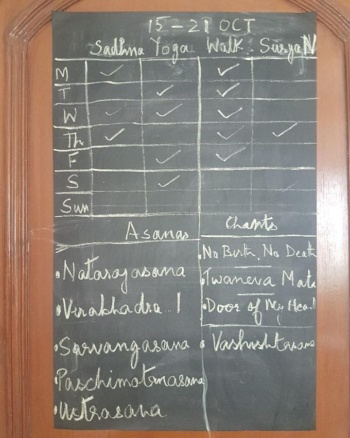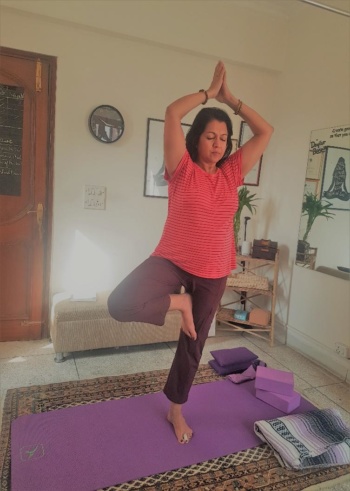When I first started teaching Ananda Yoga, I was so happy that I was able to teach 3 classes a week at the centre and one class at home. But my happiness was short lived as it suddenly struck me—could I really call myself a teacher if I did not have a practice of my own in which I prepared for the class and was yoga-ready for my students? Didn’t all teachers, professors and lecturers prepare for their class?
For many days I did nothing about it, I dilly-dallied but I did not feel good about it. I knew that I would have to address this soon.
The beginning of my home practice
As we generally do, I tried to start by telling myself I will practice for an hour every day. Did that happen? No! The reason was an incorrect assumption that a home practice should be as long as a regular yoga class, and with the same degree of focus. This idea sabotaged my efforts. Anyway, the dilly-dallying continued, until I read this beautiful article about a home practice and the way the author ended it—Just show up on the Mat!
So, started my home practice. I just began by rolling down my mat and set an intention of doing a couple of asanas every day. But the ‘every day’ part never happened. My mind was asking-why do it, how to do it, when to do it and so it continued—the excuses, the pretexts, the justifications!
The ‘Aha’ Moment
 Then came the discovery that changed everything: I was looking for some stationery online, and I found this removable peel and stick chalkboard. I bought it, wrote some instructions to MYSELF and put it behind the door of my meditation-cum-yoga room and this is what it looks like. >
Then came the discovery that changed everything: I was looking for some stationery online, and I found this removable peel and stick chalkboard. I bought it, wrote some instructions to MYSELF and put it behind the door of my meditation-cum-yoga room and this is what it looks like. >
And it worked like magic. I wrote down the names of the asanas and the chants I would be focusing on in that week. It showed me clearly at the end of the week what I had achieved and what I had not! There was no way that I could hide from it!
The board gave me a direction, made me think, allowed me variety and also acted like a supervisor and made me scurry for cover when there were more blanks than tick marks!
And I know, a few more weeks and I won’t need it any longer as my yoga ‘PRACTICE’ has begun. Sometimes all we need is self-motivation.
How to Design a Home Yoga Practice
I would like to share a few tips that helped me begin my home yoga practice.
- Carve out a space physically and mentally, literally and metaphorically— Find a place in your home and heart. Dedicate it to your home practice. Just looking at it will activate the desire to do some yoga.
- Just begin, and start small— If you want to build a regular home practice, start by choosing four or five poses that you can easily do, so that you will feel like rolling out your mat.
- Notice how you feel— If you are tired and have less time, choose a short practice. If you are feeling energetic, opt for the power poses. Respect the ebb and flow of daily life.
- Get creative— If you are not feeling well, or if you are traveling or have guests at home, find innovative ways to practice. It could mean doing the yogic breath lying down, focusing on one of your favorite affirmations, breathing diaphragmatically in the aircraft or washing the dishes with total absorption.
- No judgement— Whatever amount of time you have—10 minutes or 60 minutes—use it constructively without any guilt or judgement.
- Move in all directions–Try and select one pose for each direction—north, south, east west, movement is the best. This will help you create a complete practice.
- Don’t skip Savasana— Take the opportunity to explore Savasana. Give yourself the gift of relaxing in conscious awareness!
- Always, always have fun— Enjoy the gift of spending time with yourself.
The power of a home practice
 I am now convinced of the power of a home practice. It provides me the opportunity to tune in and also helps me notice, process and release emotional tensions into private and familiar surroundings where no one is looking, judging me or comparing me. I can do 10 minutes or 60 minutes. That is ‘me’ time. I am able to choose my direction, my pace, intensity and focus.
I am now convinced of the power of a home practice. It provides me the opportunity to tune in and also helps me notice, process and release emotional tensions into private and familiar surroundings where no one is looking, judging me or comparing me. I can do 10 minutes or 60 minutes. That is ‘me’ time. I am able to choose my direction, my pace, intensity and focus.
And because the benefits are so many, I prefer to call it a yoga sadhana instead of a practice. This sadhana has helped me immensely in my meditation by giving me focus and now both go hand-in-hand. In the words of Swami Kriyananda, “In Ananda Yoga, the main thing is its contribution towards meditation and an inner life.” My home practice has given me that gift.
I feel as a yoga teacher, I can’t really teach it without doing it myself in some way. And it is here that the first Sutra from Patanjali’s Yoga Sutras comes to mind:
Hatha yoga anushasanam, which can be interpreted as, “the subject now being offered is yoga” or even, “and now the practice of yoga begins”.

2 Comments
Very inspiring article. Thanks for sharing.
Thanks Jyoti for such an inspiring article.